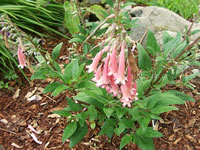Phygelius, How to Grow and Care for Cape Fuchsia Plants
Phygelius capensis
        
|

|
The common name of a Phygelius, Cape Fuchsia is misleading.
Other than the fact that the flower shape resembles that of a hardy Fuchsia, Phygelius are completely unrelated to Fuchsias. They are actually relatives of Foxgloves and Penstemons.
Growing Requirements for Cape Fuchsia Plants
Cape Fuchsias are shrubby, evergreen perennials that are hardy in USDA Zones 7-9.
In colder regions, they are grown as an annual.
Cape Fuchsias have a long blooming season from early summer until the first frost.
They are a favorite flower of hummingbirds.
Phygelius grow 3-5 feet high and wide.
They prefer full, bright sun but will tolerate periods of light shade.
They prefer a rich, well draining soil with regular watering. |
|
|
Remove the spent flowers to ensure continuous summer blooming.
In early Spring, cut the plant back to about half it's size to encourage new stems and a fuller plant.
Once established and actively growing, Cape Fuchsias should be
fed monthly with a good all-purpose fertilizer.
Propagating Cape Fuchsias
Cape Fuchsias are easily grown from seeds collected the previous year.
When the seed pods ripen, shake the seeds into a paper bag and allow them to dry completely. Store them in a cool dry place.
Phygelius seeds can be started indoors at 70 degrees or you can sow them directly into the garden in early Spring.
Cape Fuchsias can also be quickly rooted with short stem tip cuttings taken in midsummer, or by simply removing and transplanting the offset suckers from the parent plant. |
|
Cape Fuchsia
Phygelius capensis
 |
 |
A Forum discussion about Cape Fuchsia Plants
|
|
|
Search The Garden Helper:


